Highly Branched Tannin-Tris(2-aminoethyl)amine-Urea Wood Adhesives
Abstract
:1. Introduction
2. Materials and Methods
2.1. Materials
2.2. Preparation of 50% Solution of Highly Branched Polymer (HBP)
2.3. HBP-Modified Tannin Resin
2.4. Viscosity and Solid Content
2.5. Particleboard Preparation and Testing
2.6. Thermogravimetric Analysis (TGA)
2.7. Thermomechanical Analysis (TMA)
2.8. Fourier Transform Infrared (FT-IR) Spectroscopy
2.9. Matrix-Assisted Laser Desorption Ionisation Time of Flight Mass Spectrometry (MALDI ToF)
2.10. CP MAS 13C NMR
3. Results and Discussion
3.1. TMA
3.2. TGA/DTG
3.3. Properties of Particleboard
3.3.1. Viscosity and Solid Content
3.3.2. Mechanical Properties
3.4. FTIR
3.5. MALDI ToF
3.6. CP MAS 13C NMR
4. Conclusions
Supplementary Materials
Author Contributions
Funding
Institutional Review Board Statement
Data Availability Statement
Acknowledgments
Conflicts of Interest
References
- Li, K.; Geng, X.; Simonsen, J.; Karchesy, J. Novel wood adhesives from condensed tannins and polyethylenimine. Int. J. Adhes. Adhes. 2004, 24, 327–333. [Google Scholar] [CrossRef]
- Li, T.; Zhang, B.; Jiang, S.; Zhou, X.; Du, G.; Wu, Z.; Cao, M.; Yang, L. Novel highly branched polymer wood adhesive resin. ACS Sustain. Chem. Eng. 2020, 8, 5209–5216. [Google Scholar] [CrossRef]
- Davis, T.L.; Underwood, H.W. The urea dearrangement. J. Am. Chem. Soc. 1922, 44, 2595–2604. [Google Scholar] [CrossRef]
- Erickson, J.G. Reactions of long chains amines. II. reactions with urea. J. Am. Chem. Soc. 1954, 76, 3977–3978. [Google Scholar] [CrossRef]
- Olin, J.F. Manufacture and Purification of Urea Derivatives. U.S. Patent 2,257,717, 30 September 1941. [Google Scholar]
- Schweitzer, C.E. Chemical Processes and Products. U.S. Patent 2,409,712, 22 October 1946. [Google Scholar]
- Guerrero-Alburquerque, N.; Zhao, S.; Rentsch, D.; Koebel, M.M.; Lattuada, M.; Malfait, W.J. Ureido Functionalization through Amine-Urea Transamidation under Mild Reaction Condition. Polymers 2021, 13, 1583. [Google Scholar] [CrossRef] [PubMed]
- Essawy, H.A.; Moustafa, A.-A.B.; Elsayed, N.H. Improving the performance of urea-formaldehyde wood adhesive system using dendritic poly(amidoamine)s and their corresponding half generations. J. Appl. Polym. Sci. 2009, 114, 1348. [Google Scholar] [CrossRef]
- Essawy, H.A.; Moustafa, A.-A.B.; Elsayed, N.H. Enhancing the properties of urea formaldehyde wood adhesive system using different generations of core-shell modifiers based on hydroxyl-terminated dendritic poly(amidoamine)s. J. Appl. Polym. Sci. 2010, 115, 370. [Google Scholar] [CrossRef]
- Essawy, H.A.; Mohamed, H. Poly(amidoamine) dendritic structures, bearing different end groups, as adhesion promoters for urea–formaldehyde wood adhesive system. J. Appl. Polym. Sci. 2011, 119, 760. [Google Scholar] [CrossRef]
- Zhou, X.; Essawy, H.A.; Pizzi, A.; Li, X.; Rode, K.; Radke, W.; Du, G. Upgrading of MUF Wood Adhesives for Particleboard by Highly-Branched Polymers. J. Adhes. Sci. Technol. 2013, 27, 1058–1068. [Google Scholar] [CrossRef]
- Zhou, X.; Essawy, H.A.; Pizzi, A.; Li, X.; Pasch, H.; Pretorius, N.; Du, G. Poly(amidoamine)s dendrimers of different generations as components of melamine urea formaldehyde (MUF) adhesives used for particleboards production: What are the positive implications? J. Polym. Res. 2013, 20, 267–280. [Google Scholar] [CrossRef]
- Amirou, S.; Zhang, J.; Pizzi, A.; Essawy, H.; Zerizer, A.; Li, J.; Delmotte, L. Utilization of Hydrophilic/Hydrophobic Hyperbranched Poly(amidoamine)s as Additives for Melamine Urea Formaldehyde (MUF) Adhesives. Polym. Compos. 2015, 36, 2255–2264. [Google Scholar] [CrossRef]
- Li, X.; Essawy, H.; Pizzi, A.; Delmotte, L.; Rode, K.; Le Nouen, D.; Fierro, V.; Celzard, A. Modification of tannin based rigid foams using oligomers of a hyperbranched poly(amine-ester). J. Polym. Res. 2012, 19, 21–29. [Google Scholar] [CrossRef]
- Pizzi, A. Tannin-based adhesives. In Wood Adhesives: Chemistry and Technology; Marcel Dekker: New York, NY, USA, 1983; pp. 177–246. [Google Scholar]
- Pizzi, A. Advanced Wood Adhesives Technology; Marcel Dekker: New York, NY, USA, 1994; pp. 149–217. [Google Scholar]
- Ballerini, A.; Despres, A.; Pizzi, A. Non-toxic, zero-emission tannin-glyoxal adhesives for wood panels. Holz. Roh. Werkst. 2005, 63, 477–478. [Google Scholar] [CrossRef]
- Santiago-Medina, F.J.; Foyer, G.; Pizzi, A.; Calliol, S.; Delmotte, L. Lignin-derived non-toxic aldehydes for ecofriendly tannin adhesives for wood panels. Int. J. Adhes. Adhes. 2016, 70, 239–248. [Google Scholar] [CrossRef]
- Frihart, C.R.; Pizzi, A.; Xi, X.; Lorenz, L. Reactions of Soy flour and Soy protein by non-volatile aldehydes generation by specific oxidation. Polymers 2019, 11, 1478. [Google Scholar] [CrossRef]
- Braghiroli, F.L.; Fierro, V.; Izquierdo, M.-T.; Parmentier, J.; Pizzi, A.; Delmotte, L.; Celzard, A. High surface-high N-content carbons prepared by hydrothermal treatment of aminated tannin. Ind. Crops Prod. 2015, 66, 282–290. [Google Scholar] [CrossRef]
- Santiago-Medina, F.J.; Pizzi, A.; Basso, M.C.; Delmotte, L.; Celzard, A. Polycondensation resins by flavonoid tannins reaction with amines. Polymers 2017, 9, 37. [Google Scholar] [CrossRef]
- Santiago-Medina, F.J.; Pizzi, A.; Basso, M.C.; Delmotte, L.; Abdalla, S. Polycondensation resins by reaction of lignin with (poly)amines. J. Renew. Mater. 2017, 5, 388–399. [Google Scholar] [CrossRef]
- Salem, M.Z.M.; Böhm, M. Understanding of formaldehyde emissions from solid wood: An overview. Bioresources 2013, 8, 4775–4790. [Google Scholar] [CrossRef]
- Kamke, F.A.; Casey, L.J. Gas pressure and temperature in the mat during flakeboard manufacture. Forest Prod. J. 1988, 38, 41–43. [Google Scholar]
- Humphrey, P.E.; Bolton, A.J. The hot pressing of dry-formed wood-based composites, Part 2: Simulation model for heat and moisture transfer, and typical results. Holzforschung 1989, 43, 199–206. [Google Scholar] [CrossRef]
- EN 312:2010; Particleboards–Specifications. European Committee for Standardization: Bruxelles, Belgium, 2010.
- Chen, X.; Li, J.; Xi, X.; Pizzi, A.; Zhou, X.; Fredon, E.; Du, G.; Gerardin, C. Condensed Tannin-glucose-based NIPU Bio-foams of Improved Fire Retardancy. Polym. Degrad. Stab. 2020, 175, 109121. [Google Scholar] [CrossRef]
- Luo, J.; Zhou, Y.; Gao, Q.; Li, J.; Yan, N. From Wastes to Functions: A New Soybean Meal and Bark-based Adhesive. ACS Sustain. Chem. Eng. 2020, 8, 10767–10773. [Google Scholar] [CrossRef]
- Pretsch, E.; Clerc, T.; Seibl, J.; Simon, W. Tables of Spectral Data for Structure Determination of Organic Compounds: 13C-NMR, 1H-NMR, IR, MS, UV/VIS, 2nd ed.; Springer: Berlin, Germany, 1989. [Google Scholar]
- Silverstein, R.M.; Bassler, G.C.; Morrill, T.C. Spectrometric Identification of Organic Compounds, 5th ed.; Wiley: New York, NY, USA, 1991. [Google Scholar]
- Chen, X.; Xi, X.; Pizzi, A.; Fredon, E.; Zhou, X.; Li, J.; Gerardin, C.; Du, G. Preparation and Characterization of Condensed Tannin Non-Isocyanate Polyurethane (NIPU) Rigid Foams by Ambient Temperature Blowing. Polymers 2020, 12, 750. [Google Scholar] [CrossRef] [PubMed]
- Arbenz, A.; Avérous, L. Oxyalkylation of gambier tannin—Synthesis and characterization of ensuing biobased polyols. Ind. Crops Prod. 2015, 67, 295–304. [Google Scholar] [CrossRef]
- Thébault, M.; Pizzi, A.; Essawy, H.A.; Barhoum, A.; Van Assche, G. Isocyanate free condensed tannin-based polyurethanes. Eur. Polym. J. 2015, 67, 513–526. [Google Scholar] [CrossRef]
- Aristri, M.A.; Lubis, M.A.R.; Iswanto, A.H.; Fatriasari, W.; Sari, R.K.; Antov, P.; Gajtanska, M.; Papadopoulos, A.N.; Pizzi, A. Bio-Based Polyurethane Resins Derived from Tannin: Source, Synthesis, Characterisation, and Application. Forests 2021, 12, 1516. [Google Scholar] [CrossRef]
- Sealy-Fischer, V.J.; Pizzi, A. Increased pine tannins extraction and wood adhesives development by phlobaphenes minimization. Holz. Roh. Werkst. 1992, 50, 212–220. [Google Scholar] [CrossRef]
- Despres, A.; Pizzi, A.; Pasch, H.; Kandelbauer, A. Comparative 13C NMR and MALDI-TOF of species variation and structure maintenance during MUF resins preparation. J. Appl. Polym. Sci. 2007, 106, 1106–1128. [Google Scholar] [CrossRef]
- Pizzi, A.; Stephanou, A. A comparative 13C NMR study of polyflavonoid tannin extracts for phenolic polycondensates. J. Appl. Polym. Sci. 1993, 50, 2105–2113. [Google Scholar] [CrossRef]
- Newman, R.H.; Porter, L.J.; Foo, L.Y.; Johns, S.R.; Willing, R.I. High-resolution 13C NMR studies of proanthocyanidin polymers (condensed tannins). Magn. Reson. Chem. (MRC) 1987, 25, 118–124. [Google Scholar] [CrossRef]
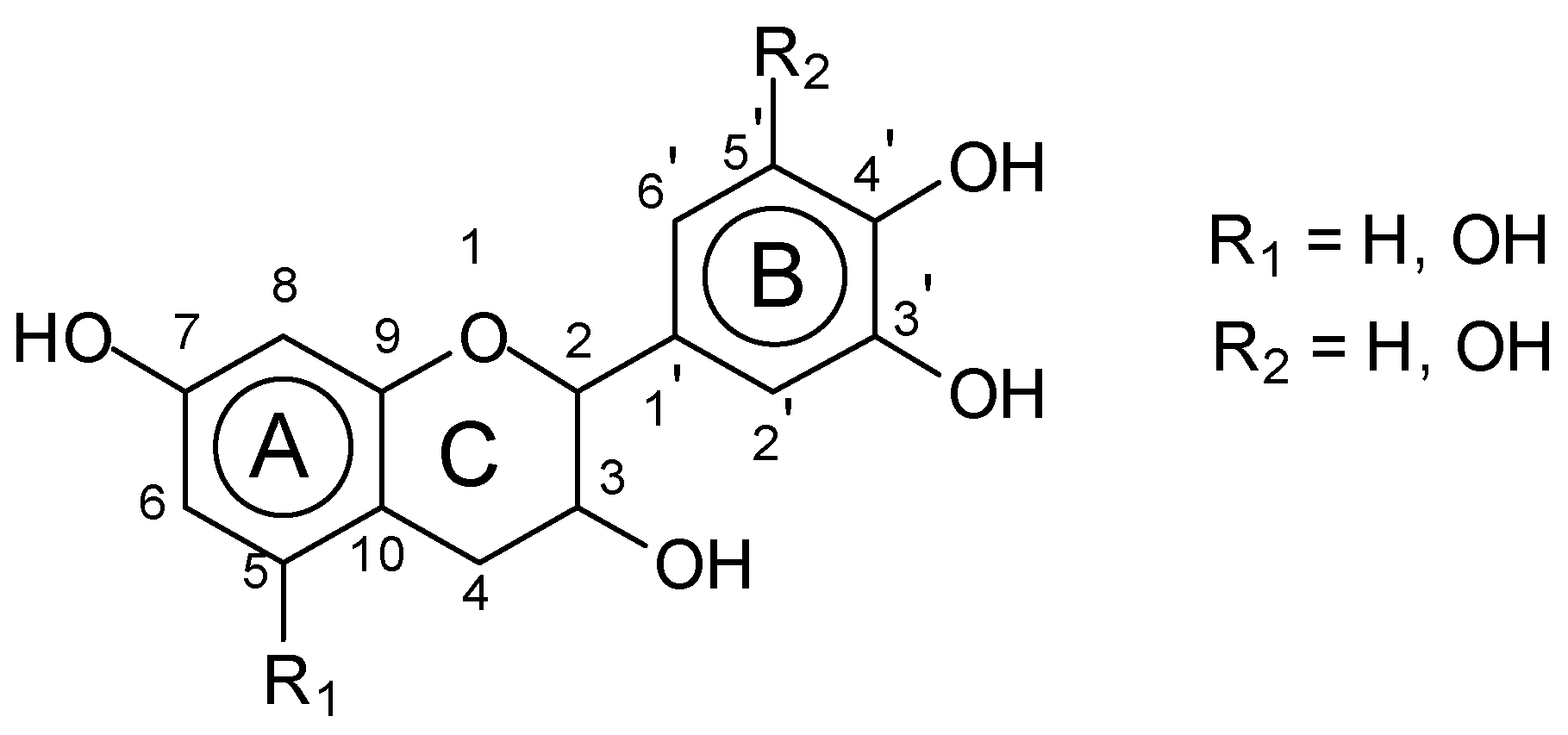
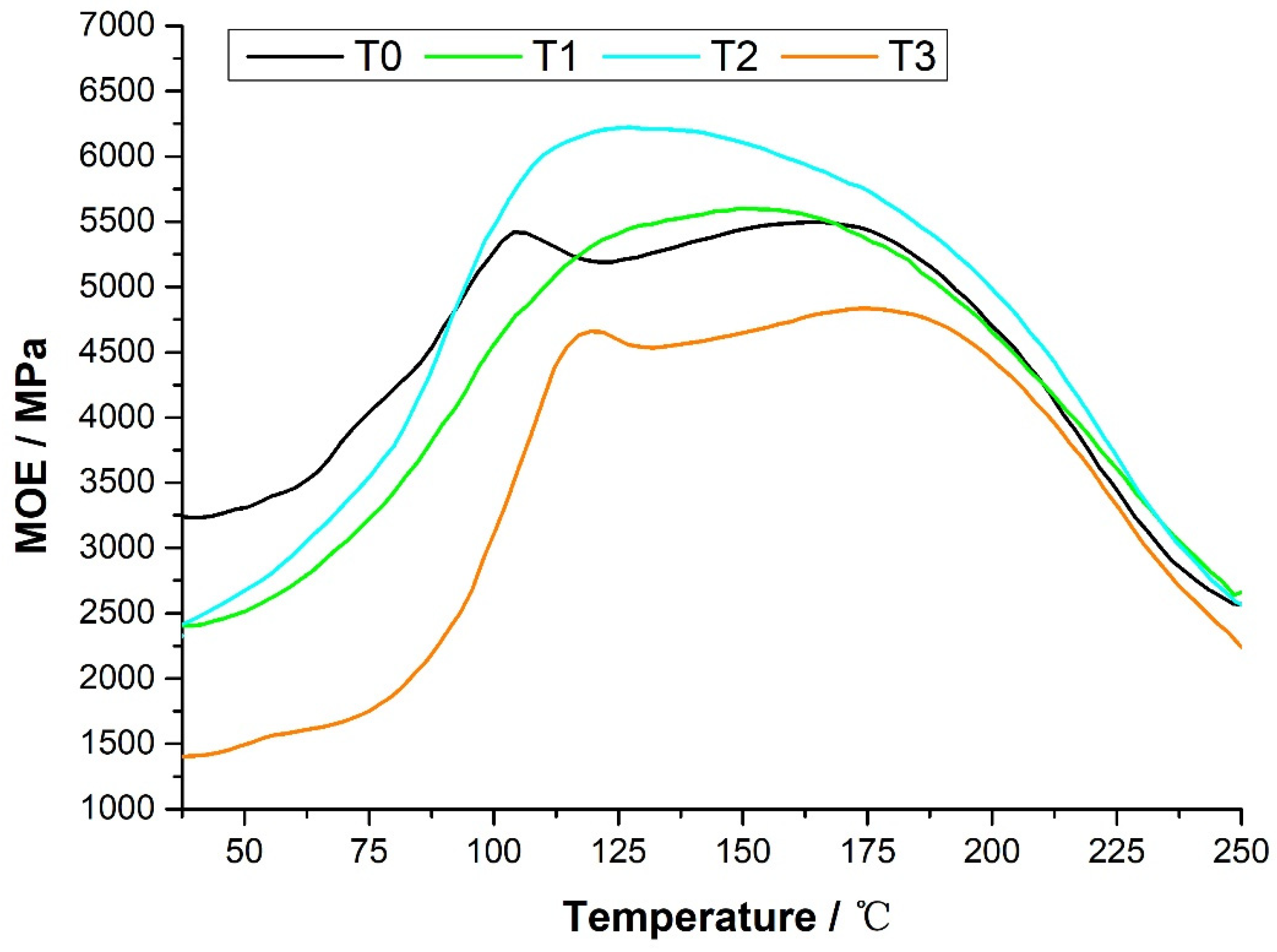

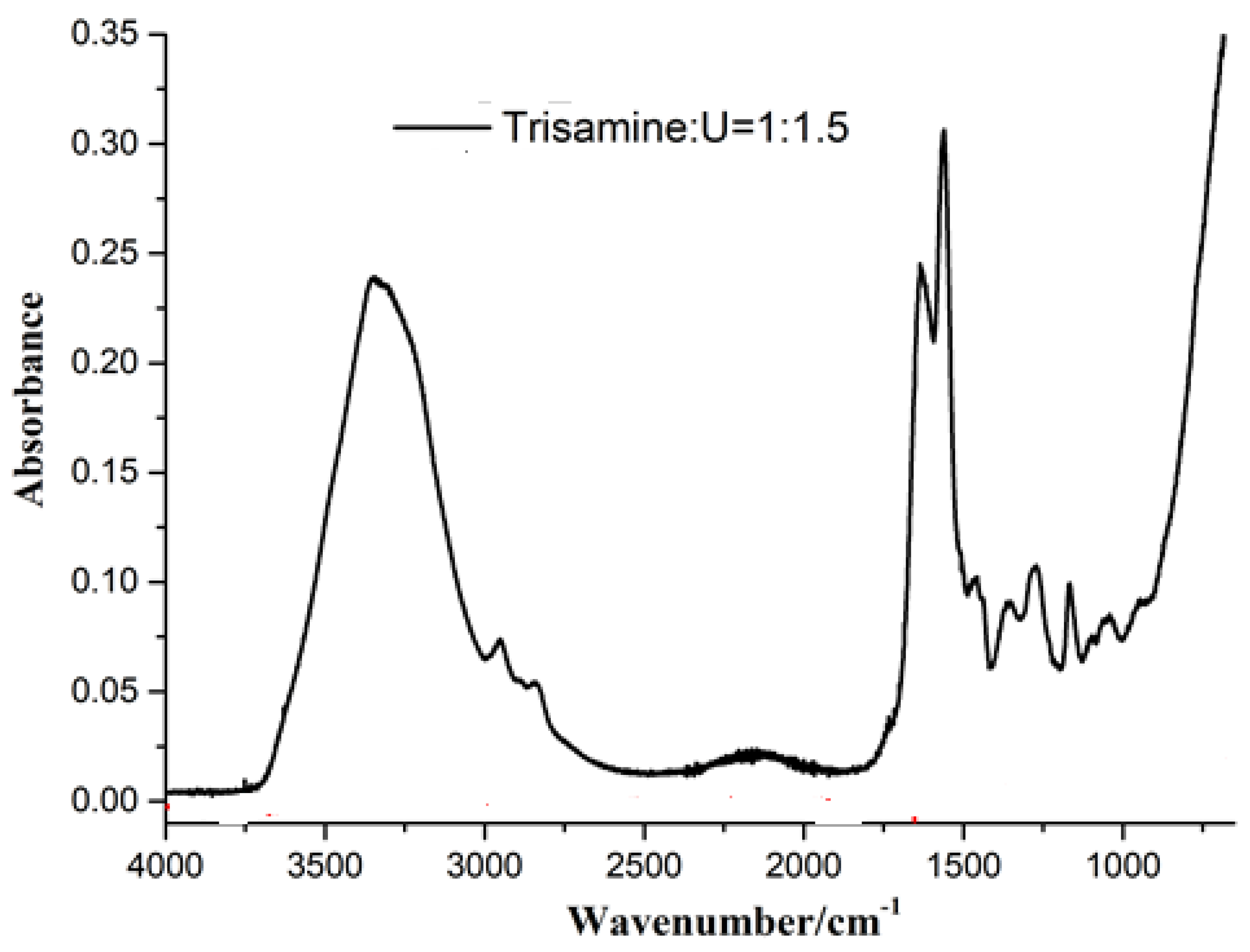
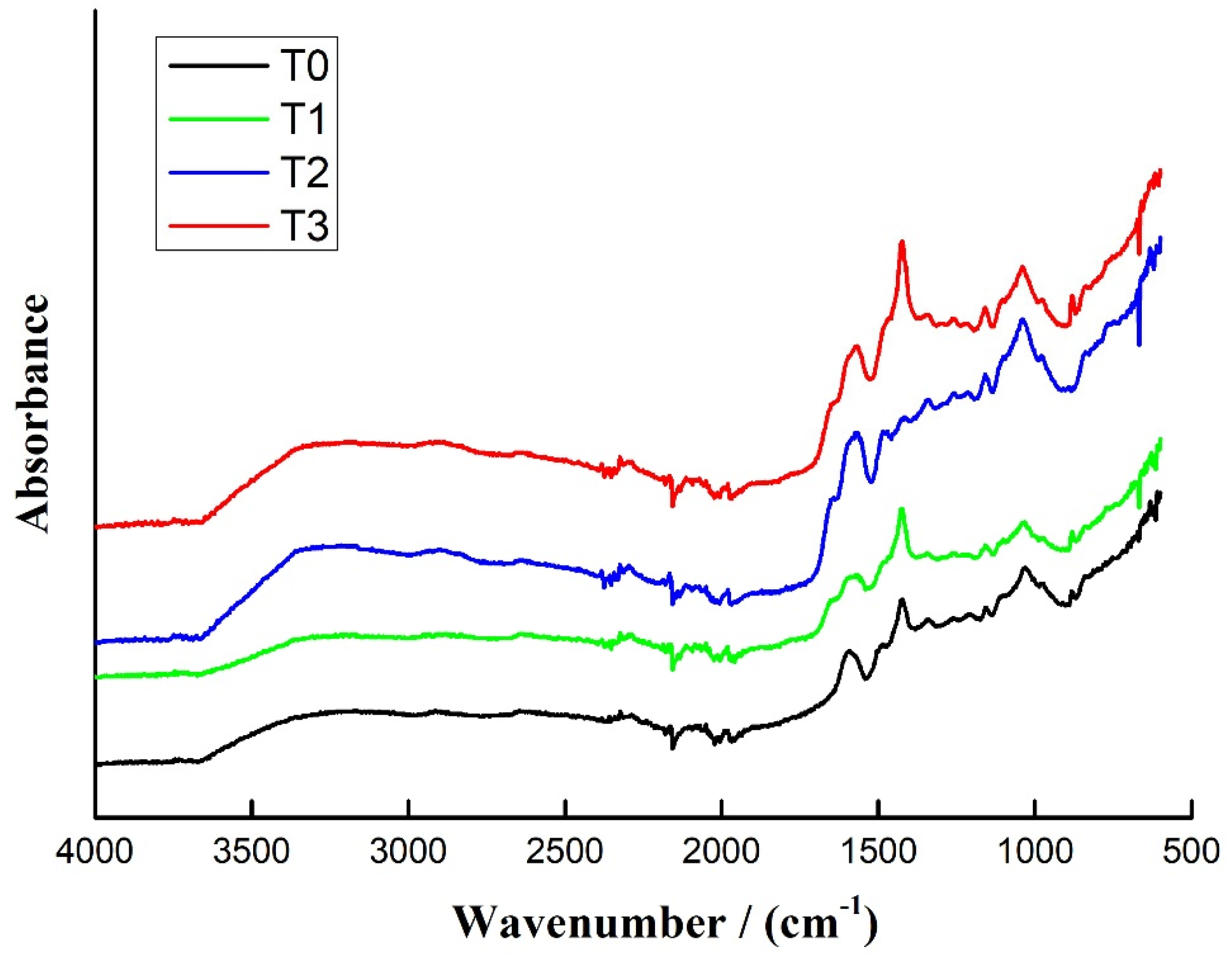

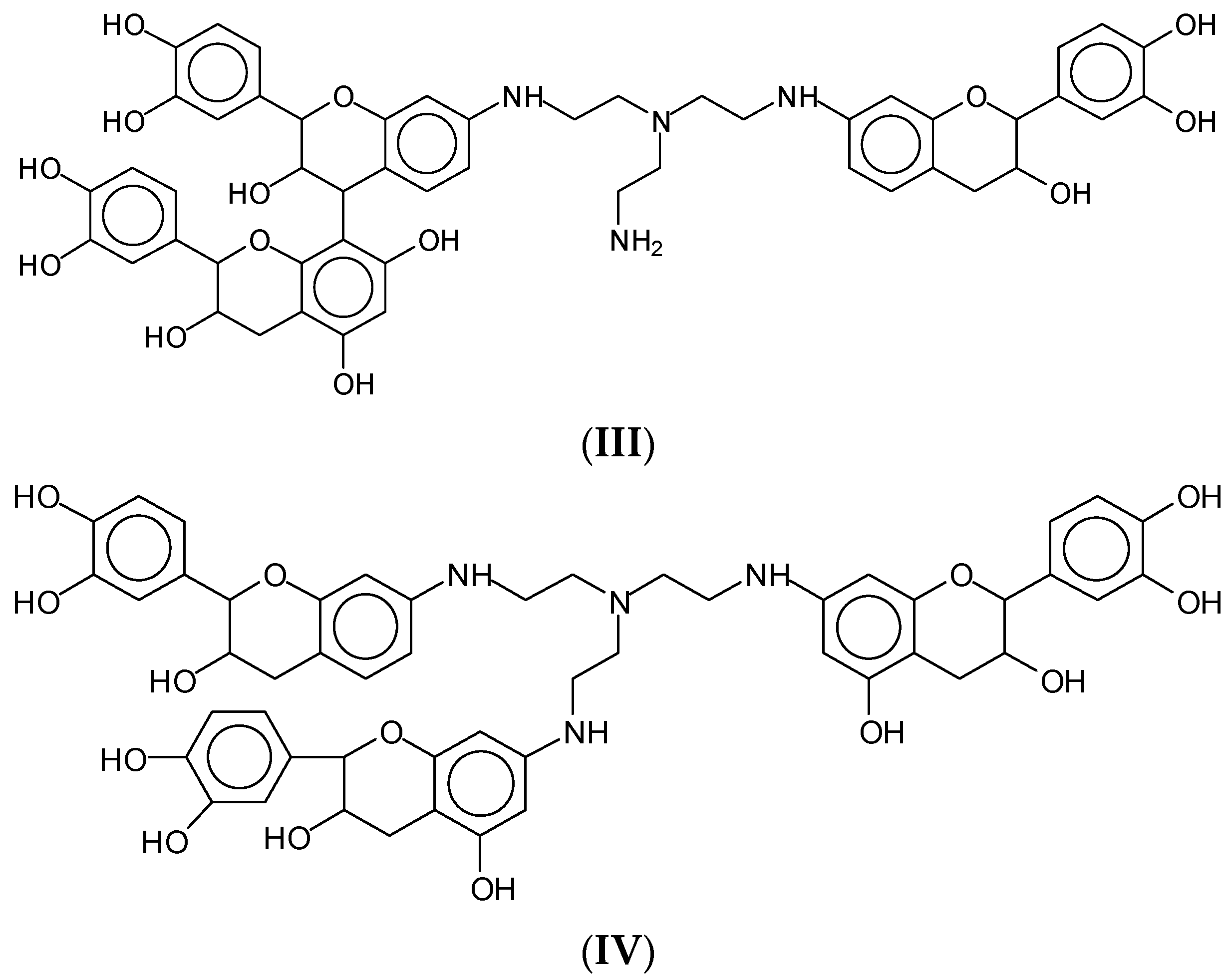






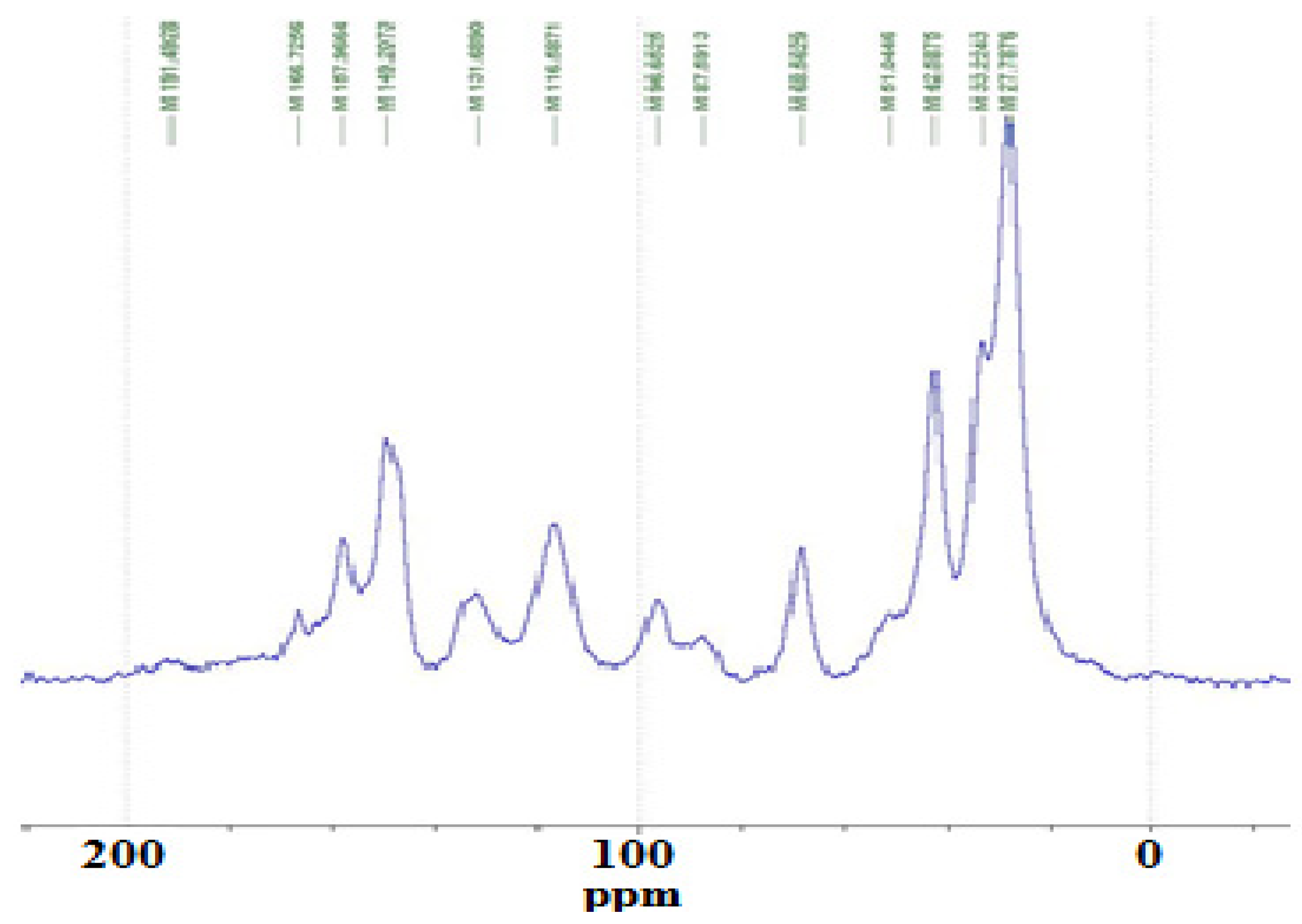
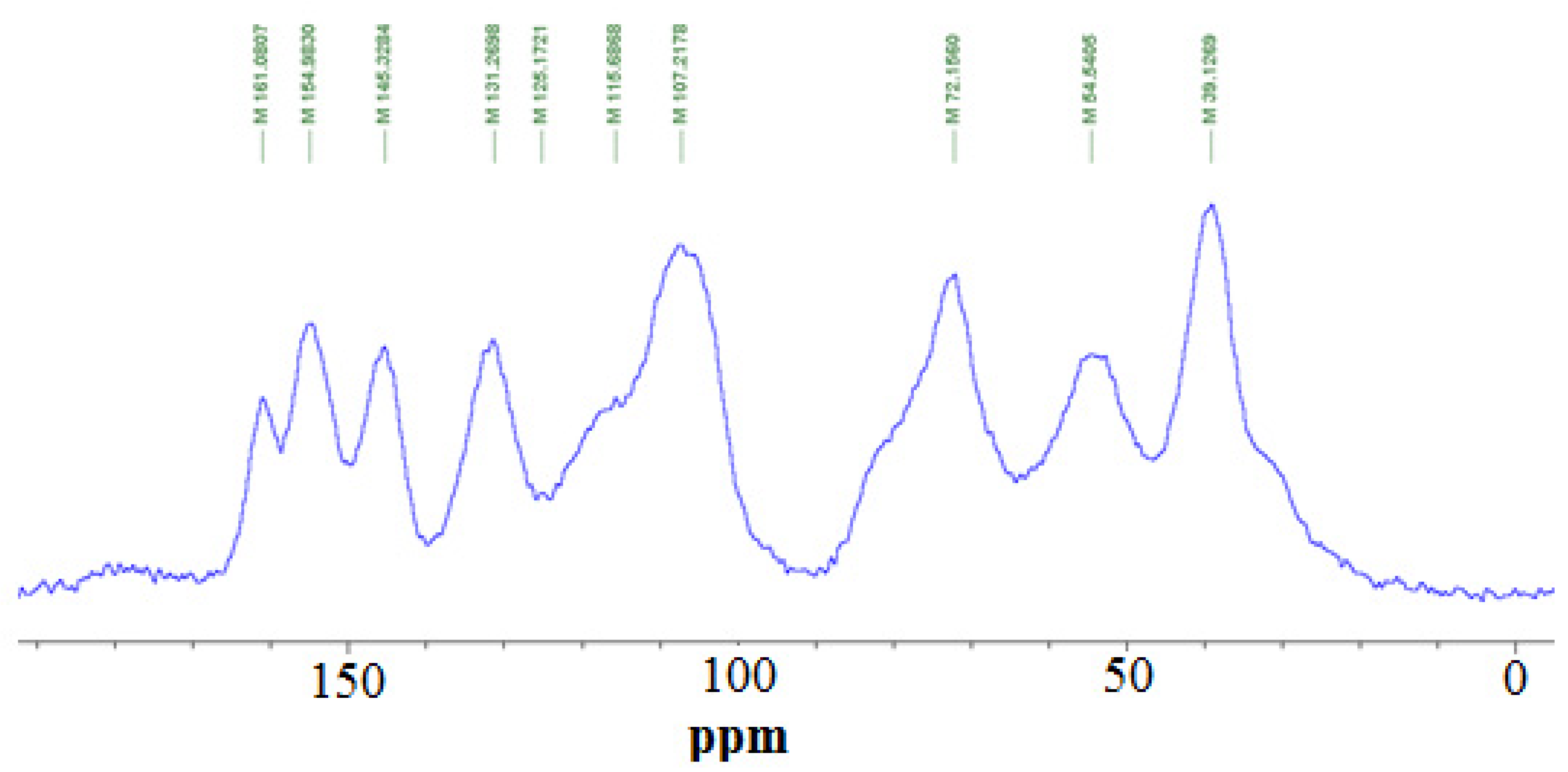
| Resin | Proportions | pH | Resin Name |
|---|---|---|---|
| HBP:Tannin | 0:1 (Control) | 10 | T0 |
| HBP:Tannin | 1:4 | 10 | T1 |
| HBP:Tannin | 1:5 | 10 | T2 |
| HBP:Tannin | 1:6 | 10 | T3 |
| Resin | Rotating Rate (r/s) | Viscosity (mPa.s) |
|---|---|---|
| T0 | 1 | 6900–7000 |
| T1 | 1 | 4600–4800 |
| T2 | 1 | 3200–3300 |
| T3 | 1 | 4400–4500 |
| T0 | 2.5 | 3880–3920 |
| T1 | 2.5 | 2680–2720 |
| T2 | 2.5 | 1840–1880 |
| T3 | 2.5 | 2440–2480 |
| T0 | 5 | 2660–2700 |
| T1 | 5 | 1780–1800 |
| T2 | 5 | 1260–1280 |
| T3 | 5 | 1600–1620 |
| T0 | 10 | 1870–1890 |
| T1 | 10 | 1240–1250 |
| T2 | 10 | 900–910 |
| T3 | 10 | 1100–1110 |
| T0 | 20 | 1365–1375 |
| T1 | 20 | 905–910 |
| T2 | 20 | 670–575 |
| T3 | 20 | 795–805 |
| Resin | Solid Content (%) | Bending Strength (MPa) | Internal Bond Strength (MPa) | Board Density (g/cm3) | 2 h Thickness Swelling (%) | 24 h Thickness Swelling (%) |
|---|---|---|---|---|---|---|
| T0 | 41.0 ± 0.43 | 9.08 ± 1.83 | 0.24 ± 0.04 | 0.810 ± 0.02 | 62.1 ± 4.2 | 63.5 ± 2.1 |
| T1 | 40.3 ± 0.46 | 11.53 ± 2.11 | 0.62 ± 0.11 | 0.770 ± 0.03 | 36.6 ± 1.4 | 51.6 ± 1.0 |
| T2 | 39.8 ± 0.32 | 11.22 ± 1.12 | 0.64 ± 0.12 | 0.770 ± 0.01 | 36.1 ± 1.9 | 49.4 ± 1.5 |
| T3 | 39.5 ± 0.10 | 13.48 ± 1.32 | 0.70 ± 0.07 | 0.750 ± 0.01 | 36.7 ± 1.5 | 50.2 ± 2.7 |
| EN312 | ≥0.35 |
Disclaimer/Publisher’s Note: The statements, opinions and data contained in all publications are solely those of the individual author(s) and contributor(s) and not of MDPI and/or the editor(s). MDPI and/or the editor(s) disclaim responsibility for any injury to people or property resulting from any ideas, methods, instructions or products referred to in the content. |
© 2023 by the authors. Licensee MDPI, Basel, Switzerland. This article is an open access article distributed under the terms and conditions of the Creative Commons Attribution (CC BY) license (https://creativecommons.org/licenses/by/4.0/).
Share and Cite
Zhang, B.; Chen, X.; Pizzi, A.; Petrissans, M.; Dumarcay, S.; Petrissans, A.; Zhou, X.; Du, G.; Colin, B.; Xi, X. Highly Branched Tannin-Tris(2-aminoethyl)amine-Urea Wood Adhesives. Polymers 2023, 15, 890. https://doi.org/10.3390/polym15040890
Zhang B, Chen X, Pizzi A, Petrissans M, Dumarcay S, Petrissans A, Zhou X, Du G, Colin B, Xi X. Highly Branched Tannin-Tris(2-aminoethyl)amine-Urea Wood Adhesives. Polymers. 2023; 15(4):890. https://doi.org/10.3390/polym15040890
Chicago/Turabian StyleZhang, Bengang, Xinyi Chen, Antonio Pizzi, Mathieu Petrissans, Stephane Dumarcay, Anelie Petrissans, Xiaojian Zhou, Guanben Du, Baptiste Colin, and Xuedong Xi. 2023. "Highly Branched Tannin-Tris(2-aminoethyl)amine-Urea Wood Adhesives" Polymers 15, no. 4: 890. https://doi.org/10.3390/polym15040890
APA StyleZhang, B., Chen, X., Pizzi, A., Petrissans, M., Dumarcay, S., Petrissans, A., Zhou, X., Du, G., Colin, B., & Xi, X. (2023). Highly Branched Tannin-Tris(2-aminoethyl)amine-Urea Wood Adhesives. Polymers, 15(4), 890. https://doi.org/10.3390/polym15040890











